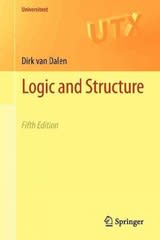Question
Tests of Normality Kolmogorov-Smirnov a Shapiro-Wilk Statistic df Sig. Statistic df Sig. quiz3 .140 105 .000 .935 105 .000 a. Lilliefors Significance Correction Interpret the
Tests of Normality | ||||||
Kolmogorov-Smirnova | Shapiro-Wilk | |||||
Statistic | df | Sig. | Statistic | df | Sig. | |
quiz3 | .140 | 105 | .000 | .935 | 105 | .000 |
a. Lilliefors Significance Correction |
Interpret the Shapiro-Wilk test and how you determined whether the assumption of normality was met or violated.
Descriptives | ||||||||
| quiz3 | ||||||||
N | Mean | Std. Deviation | Std. Error | 95% Confidence Interval for Mean | Minimum | Maximum | ||
Lower Bound | Upper Bound | |||||||
1 | 33 | 7.24 | 1.324 | .230 | 6.77 | 7.71 | 5 | 10 |
2 | 39 | 6.72 | 1.538 | .246 | 6.22 | 7.22 | 4 | 10 |
3 | 33 | 7.82 | 1.976 | .344 | 7.12 | 8.52 | 4 | 10 |
Total | 105 | 7.23 | 1.677 | .164 | 6.90 | 7.55 | 4 | 10 |
Report the means and standard deviations of quiz3 for each group of the section variable.
ANOVA | |||||
| quiz3 | |||||
Sum of Squares | df | Mean Square | F | Sig. | |
Between Groups | 21.647 | 2 | 10.824 | 4.076 | .020 |
Within Groups | 270.867 | 102 | 2.656 | ||
Total | 292.514 | 104 |
Report the results of the F test and interpret the statistical results against the null hypothesis and state whether it is accepted or rejected.
Multiple Comparisons | ||||||
| Dependent Variable: quiz3 | ||||||
| Tukey HSD | ||||||
(I) section | (J) section | Mean Difference (I-J) | Std. Error | Sig. | 95% Confidence Interval | |
Lower Bound | Upper Bound | |||||
1 | 2 | .524 | .385 | .365 | -.39 | 1.44 |
3 | -.576 | .401 | .327 | -1.53 | .38 | |
2 | 1 | -.524 | .385 | .365 | -1.44 | .39 |
3 | -1.100* | .385 | .014 | -2.02 | -.18 | |
3 | 1 | .576 | .401 | .327 | -.38 | 1.53 |
2 | 1.100* | .385 | .014 | .18 | 2.02 | |
*. The mean difference is significant at the 0.05 level. |
Finally, if the F is significant, interpret the post-hoc tests (multiple comparisons).
1. Provide a brief summary of your analysis and the conclusions drawn.
2. Analyze the limitations of the statistical test.
3. Provide any possible alternate explanations for the findings and potential areas for future exploration.
Step by Step Solution
There are 3 Steps involved in it
Step: 1

Get Instant Access to Expert-Tailored Solutions
See step-by-step solutions with expert insights and AI powered tools for academic success
Step: 2

Step: 3

Ace Your Homework with AI
Get the answers you need in no time with our AI-driven, step-by-step assistance
Get Started


